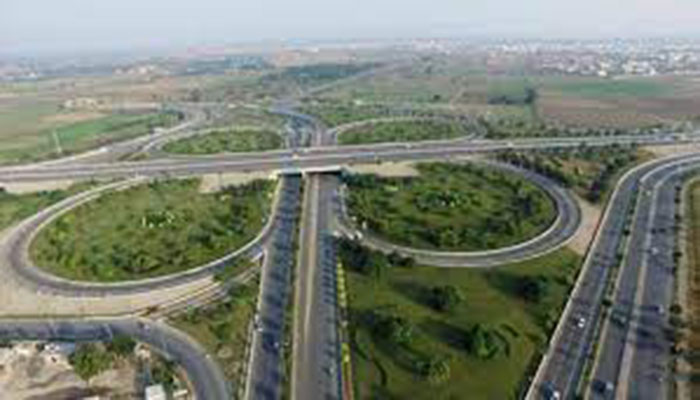Rawalpindi Ring Road project: Govt-adopted minority inquiry report devoid of versions of accused
ISLAMABAD: Rawalpindi Commissioner Gulzar Shah’s fact-finding report into the aborted Rawalpindi Ring Road (R3) project, which the government has adopted and is acting upon, does not contain a word in defence from at least three dozen officials, private parties and housing societies that have been named and accused of serious misdemeanours.
A reading of the 33-page report shows that at no point did the commissioner summon the “delinquents” to confront them with his findings, observations and conclusions before implicating them in the mega scandal. If he ever gave them a hearing, it is not reflected in his report. The report uses strong words against those it found responsible for the scam. Among others, it uses terms such as “unethical silence” and “rent seeking syndicate” to describe them and their actions.
The terms of reference (TORs) framed by the Punjab government for the inquiry committee said that the forum could consult domain experts, academia and the necessary stakeholders and submit its recommendations accordingly. It “will identify public policy gaps leading to rent seeking from infrastructure development and make recommendations for stopping rent seeking-driven infrastructure expansion”.
The inquiry report named ex-commissioner Muhammad Mahmood, his brother, former land acquisition collector (LAC) Wasim Ali Tabish, member of the Planning & Development (P&D) Department Punjab Farrukh Navid, the former director general of the Rawalpindi Development Authority (RDA), NESPAK officers, several private housing societies, real estate players and others.
The report recommended that the Federal Investigation Agency (FIA) and Federal Board of Revenue (FBR) should inquire about the housing societies and properties for being “benami fronts of past or present public office holders, public servants and/or tax evaders”. It also suggested that the cases of some administration officials, including Muhammad Mahmood and Tabish, should be referred to the National Accountability Bureau (NAB).
It further proposed that the relevant authorities in the armed forces should be informed of the role of retired Maj-Gen Saleem Ishaque for which they may proceed further under the armed forces’ internal accountability system.
The report recommends civil awards to two officers for their critical contributions to the identification, collection and compilation of the necessary facts and information to meet the 10-day deadline. They include Muhammad Zeeshan Amin, financial specialist, Project Management Unit (PMU) for his fearless disclosures and the provision of critical documents, and Muhammad Arif Qureshi, assistant commissioner, revenue (ACR), Rawalpindi division, who is the staff officer of the commissioner, for his hard work, presence of mind and remaining steady under immense peer pressure.
Strangely, the findings dubbed the feasibility report prepared by the Shehbaz Sharif government on the R3 as suitable and rejected the one approved by all the relevant official forums of the present provincial administration.
Officials aware of the developments said that in fact no feasibility report had been formulated by the previous government. “It was only a concept paper that Shehbaz Sharif as Punjab chief minister had taken with him to lay before the Asian Infrastructure Development Bank (AIIB) in China five years back,” one official told The News.
He said that no feasibility report was ever given the green light by the P&D of the Punjab government in a formal manner. The AIIB had then committed a $400m loan for the R3. However, the previous government could not pull off the project because of preparations for the 2018 general elections.
After the exit of the Shahbaz Sharif government, the AIIB waited for more than a year and finally went back on its commitment because of the delay on the part of the provincial administration, the official said. He added that the merger of the R3 alignment with the motorway at some points was also turned down by the National Highway Authority (NHA). It argued that it would not allow the R3 to use the motorway. The NHA’s stand was that the axle load was different for the motorway and other highways and roads including the R3 and it could not permit all sorts of traffic from the R3 on the motorway. Ultimately, the then proposed R3 alignment was shot down and the work started on the preparation of the feasibility report by the incumbent government for the now-aborted ring road.
The commissioner’s inquiry report noted that in 2016, the Punjab government decided to undertake the R3 project on a public-private partnership (PPP) mode through the RDA. A joint venture including NESPAK and KPMG was hired for the feasibility study, preliminary design and transaction advisory services as transaction adviser (TA) for taking up the construction of the R3 in the PPP mode.
The report listed the facts supporting the contention that could be deemed as a reasonably suitable alignment. NESPAK initially submitted the alignment to their client, RDA, in 2017. In Dec 2017, the final document of the alignment was given and presented in discussions during the AIIB visit in Feb 2018.
It said that the NESPAK alignment delivered to the RDA in 2017 formed the basis on which the communication & works (C&W) department of Punjab sent a summary to the chief minister on March 7, 2018.
The initial feasibility studies were carried out by the RDA through NESPAK which were accepted by the AIIB mission. The C&W additional chief secretary, P&D chairman and Housing, Urban Development & Public Health Department secretary positively commented upon the feasibility in the summary, which was approved by the chief minister on March 27, 2018.
The report said that these feasibility studies were the proposed alignment on which M/s Zeeruk were hired by the RDA to prepare the detailed design for the construction of the R3. Since the summary was submitted on the basis of NESPAK’s proposed alignment and the approval was accorded by the chief minister on the strength of duly made comments by various departments and the P&D board chairman, it is therefore the chief minister approved alignment. After that, no other alignment has the same status.
This approval, the report said, may very well be construed as an approval by the government unless it is proved that in the then government, stricto sensu compliance of the Supreme Court judgment in the Mustafa Impex case was widely prevalent in matters of a similar nature. Any changes in the essentials of this alignment, except detailed designs etc., therefore, would require the chief minister’s approval before proceeding any further.
-
 Kate Middleton Is More Relaxed In 'Wellington Boots Than Diamond Tiara'
Kate Middleton Is More Relaxed In 'Wellington Boots Than Diamond Tiara' -
 Gaten Matarazzo Addresses Important Fans Query About 'Stranger Things'
Gaten Matarazzo Addresses Important Fans Query About 'Stranger Things' -
 Prince William's Latest Move Reveals Rift Is Strong With Prince Harry
Prince William's Latest Move Reveals Rift Is Strong With Prince Harry -
 Princess Eugenie Becomes Second Royal After Meghan To Feature In Viral Trend
Princess Eugenie Becomes Second Royal After Meghan To Feature In Viral Trend -
 Carol Burnett Sings Praises Of Late Jimmy Stewart: 'He Had THIS'
Carol Burnett Sings Praises Of Late Jimmy Stewart: 'He Had THIS' -
 Kate Middleton Dashes Through Rain At Windsor Castle
Kate Middleton Dashes Through Rain At Windsor Castle -
 Dave Filoni, Who Oversaw Pedro Pascal's 'The Mandalorian' Named President Of 'Star Wars' Studio Lucasfilm
Dave Filoni, Who Oversaw Pedro Pascal's 'The Mandalorian' Named President Of 'Star Wars' Studio Lucasfilm -
 Is Sean Penn Dating A Guy?
Is Sean Penn Dating A Guy? -
 Sebastian Stan's Godmother Gives Him New Title
Sebastian Stan's Godmother Gives Him New Title -
 Alison Arngrim Reflects On 'Little House On The Prairie' Audition For THIS Reason
Alison Arngrim Reflects On 'Little House On The Prairie' Audition For THIS Reason -
 Spencer Pratt Reflects On Rare Bond With Meryl Streep's Daughter
Spencer Pratt Reflects On Rare Bond With Meryl Streep's Daughter -
 'Stranger Things' Star Gaten Matarazzo Recalls Uncomfortable Situation
'Stranger Things' Star Gaten Matarazzo Recalls Uncomfortable Situation -
 Gaten Matarazzo On Unbreakable Bonds Of 'Stranger Things'
Gaten Matarazzo On Unbreakable Bonds Of 'Stranger Things' -
 Beyonce, Jay-Z's Daughter Blue Ivy Carter's Massive Fortune Taking Shape At 14?
Beyonce, Jay-Z's Daughter Blue Ivy Carter's Massive Fortune Taking Shape At 14? -
 Meghan Markle Fulfills Fan Wish As She Joins Viral 2106 Trend
Meghan Markle Fulfills Fan Wish As She Joins Viral 2106 Trend -
 Selena Gomez Proves Point With New Makeup-free Selfie On Social Media
Selena Gomez Proves Point With New Makeup-free Selfie On Social Media




